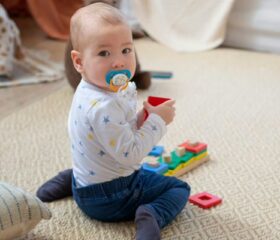Wake Windows by Age: How to Help Your Baby Sleep Better
Few things are more draining and frustrating than trying to crack the enigma of infant sleep patterns. Just when you think you have everything figured out—wham! Your sweet pea decides that 3 AM wake-ups are the new normal.

Luckily, understanding wake windows can make your baby’s trips to dreamland seem less random.
From identifying telltale signs of tiredness to tracking typical waking times by age, here’s how to know when your baby is ready for her daytime nap or her (hopefully) all-night sleep fest.
What are wake windows?
A wake window represents how long your baby can comfortably stay awake between sleep periods. You can think of it as the sweet spot between your little one being tired enough to fall asleep easily and overtired to the point of having trouble settling down.
Your baby’s growth and development lengthens these wake windows naturally. Newborns doze off at the drop of a hat, while many toddlers refuse to lie down once they get going.
Why are wake windows important?
Paying attention to wake windows helps you predict when your baby needs sleep. The stress of staying awake for too long may release a hormone called cortisol. If this happens, you can expect a more restless baby who has trouble falling and staying asleep. 1
Wake windows by age: a detailed look
Wake windows aren’t set in stone and will keep you on your toes during the first year, so treat them more like guidelines than gospel. Here’s a general idea of how wake windows change over time. 2
Newborns (0–4 weeks old)
Thanks to an underdeveloped circadian system, newborn sleep is chaotic and unpredictable, which sometimes means your baby won’t sleep even when you’re down for the count yourself. 3
On the flipside, many newborns have wake windows of only 30–90 minutes, so try not to worry if it seems like your baby is sleeping too much. Expect lots of short-lived daytime napping when your baby is one week old to four weeks old.
It’s normal for your baby to have day-night confusion initially, but this should clear up within a couple of months. To help her establish the right circadian rhythm, wake your baby during the day to feed frequently (i.e., cluster feed) and do your best to help her sleep longer at night.
Your newborn may also cry for long periods for seemingly no reason (also known as PURPLE crying) or fall prey to the infamous (albeit anecdotal) baby witching hour. This is a period of the day when your baby might be especially fussy and restless. Despite the name, it’s not just a single hour—it can last anywhere from half an hour to 2 hours, usually between 5 and 11 pm.
Infants (1–4 months old)
By this stage, your baby should be active for 1 to 3 hours at a time. Her napping here is more consistent, and bedtime is more regular.
This pivot to a more mature sleep cycle at 3 months can lead to a sleep regression (sudden sleep instability) as your baby adjusts. The transition is your signal to start establishing a healthy sleep routine. 4
Infants (5–7 months old)
At this point, wake windows clock in at about 2–4.5 hours, and predictability becomes key as your baby’s internal sleep processes mature. If she needs a third nap during the day, it’ll be short.
She’ll still call out for you at night; most 5-month-old to 7-month-old babies aren’t quite ready to sleep through it just yet.
Infants (7–10 months old)
Here, you’ll see a jump in your baby’s wake window to 2.5–6 hours. You can expect a more reliable 2-nap schedule and steadier night sleep with fewer wake-ups by the time your baby is 10 months old. Hopefully, it won’t be much longer before your baby starts sleeping through the night.
Infants and toddlers (10–12 months old)
Hooray for longer wake windows! On the cusp of toddlerhood, your child will be able to stay awake from 3 to 7.5 hours at a stretch when she hits 12 months old.
You can credit some of this to developments like crawling and walking. Give her plenty of room to roam, and watch her go out like a light when bedtime rolls around.
Recognizing your baby's sleep cues
While wake windows provide a helpful sleep-time framework, they aren’t the whole picture. You’ll need to pay attention to your baby’s individual sleep cues to time things perfectly and avoid overtiredness.
Here are some common tip-offs for when your baby’s tired enough to sleep: 5
- Yawning
- Eye rubbing
- Staring or glazed look
- Fussiness or irritability
- Head turning
Start your sleep routine if your baby shows two or more of these cues. You’ll need to be quick about it, too, since she’s already close to being overtired.
Setting the stage for sleep
Here are some tips to build a sleep-friendly atmosphere for your baby: 6
- Routine: Predictable bedtime and nap routines set your baby up for solid sleep. Try a bath, a story, or some quiet cuddles.
- Light: Cut the lights to let your baby know it’s time to get some shut-eye. Use blackout curtains during naps and at night.
- Temperature: Some studies suggest the most comfortable room temperature for your baby is between 68 and 72 degrees Fahrenheit. 7
- White noise: A white noise machine helps drown out distracting sounds for a calmer environment.
- Safe sleep practices: Always rest your baby on her back on a firm, flat mattress, free of loose bedding and toys. For infants, consider using a sleep sack instead of a blanket. 8
When to adjust wake windows
There’s no set time to adjust your baby’s wake windows, but she’ll let you know that she’s ready to stay up longer if:
- She’s consistently energetic, happy, and playful at the end of her current wake window.
- She fights your attempts to put her down for a nap or bedtime.
- She takes very short naps or skips them altogether.
When you see these indicators, it’s time for an adjustment. However, avoid the temptation to change your baby’s routine drastically, which can be disruptive. Instead, increase her wake window a little bit every time.
Final thoughts
Understanding wake windows can quickly turn your all-nighters from a special kind of torture into semi-pleasant memories to look back on fondly. Through it all, try to remain patient—learning your little one’s unique sleep language takes practice.
With consistency, coffee, and expert observation skills, those baby wake-up sessions will soon feel as natural as brushing your teeth. If these efforts fall short, don’t hesitate to reach out to your pediatrician with lingering concerns or questions. Good luck, and sweet dreams to your little one!
Article Sources
- The University of Chicago Medicine. "A parent’s guide to sleep training infants and toddlers" Retrieved July 3, 2025.
- Sleep Foundation. "Newborn Wake Windows: What’s Normal?" Retrieved July 3, 2025.
- Neoreviews. "Circadian Rhythms in Infants" Retrieved July 3, 2025.
- Sleep Foundation. "4-Month Sleep Regression" Retrieved July 3, 2025.
- Cleveland Clinic. "15 Signs That Your Baby Is Tired" Retrieved July 3, 2025.
- Harvard Health Publishing. "New advice on melatonin use in children" Retrieved July 3, 2025.
- Sleep Foundation. "What Is the Best Room Temperature for a Sleeping Baby?" Retrieved July 3, 2025.
- Johns Hopkins Medicine. "The ABCs of Safe Sleep" Retrieved July 3, 2025.







